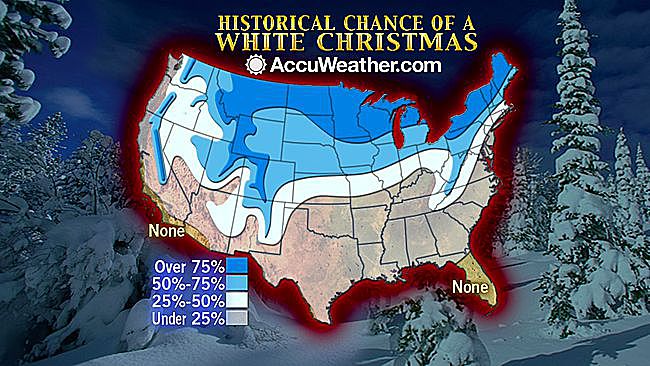AccuWeather reports while many people across the country are likely dreaming of a white Christmas, some cities offer a better probability than others for snow on the ground each holiday.
Even if a light dusting is present on Christmas Day, in order to garner the official meteorological declaration of a white Christmas, at least 1 inch of snow must be on the ground.
“You need snow – on or near Christmas Day is ideal,” AccuWeather.com Meteorologist Jim Andrews said. “Of course, if it happens well before Christmas, it needs to stay cold (near to below freezing) through Christmas to keep snow on the ground.”
Also, a cold snap before the snowfall is helpful in chilling the ground, he said, adding that frozen ground holds snow much better than unfrozen ground.
Areas of the interior Northeast, Upper Midwest, northern Plains, Rocky Mountains and Intermountain West offer the highest prospect of a white Christmas in the continental United States.
Take a look at five of America’s major cities with populations of more than 250,000 that are most likely to see a white Christmas each year based on NOAA’s 30-year normal data from 1981-2010.
Minneapolis
Minneapolis takes the number one spot on our list with a 77 percent likelihood of having at least an inch of snow on the ground for the Christmas holiday. The city’s December snowfall average is 11.5 inches and the snowiest Christmas on record occurred in 1945 with a snowfall total of 9.6 inches.
“Minneapolis is farthest north and the coldest of the cities [on the list],” Andrews said. “By the time you get to Christmas, the normal temperature is well below freezing; if there’s precipitation, the odds are that it will be snow rather than rain or ice.”
Denver
Taking the number two spot on the list with a 50 percent prospect of seeing a white Christmas, Denver has an average December snowfall of 8.7 inches. The snowiest Christmas Day in the Mile-High City’s recorded history occurred in 2007 with a total of 7.4 inches.
“Denver’s climate is volatile in December,” Andrews said. “It can be exceptionally warm on Christmas day with temperatures nearing 70 F, or it be near minus 20 F; those are absolute extremes.”
If the pattern is such that the normal, moderating westerly winds are shut off, the cold can hold its ground there and keep snow locked in, he added.
Milwaukee
Along with two other cities on this list, Milwaukee ties for third place with a 47 percent probability of a white Christmas. The city sees an average of 10.6 inches of snowfall in December. The snowiest Christmas in the city’s recorded history occurred in 1950 with a total of 5.7 inches of snow.
“[The probability] has to do with the normal temperature and normal precipitation in the days and weeks leading up to Christmas,” Andrews said.
Detroit
Detroit, like Milwaukee, has a 47 percent prospect of having at least 1 inch or more of snow on the ground at Christmas each year. The average snowfall for December across the Motor City is 9.7 inches.
While the 2013-2014 season marked the snowiest winter in the city’s history, Detroit’s snowiest Christmas day occurred in 1915 with a snowfall total of 7.9 inches.
“While Detroit does not benefit from lake-effect snow, it is usually cold enough [in December] for precipitation to often take the form of snow, thereby giving the city a significant chance of a white Christmas,” Andrews said.
Buffalo
As with Detroit and Milwaukee, there is a 47 percent likelihood that Buffalo will have a white Christmas each year. Buffalo has the highest December snowfall average on the list with 27.4 inches. The snowiest Christmas Day the city has seen in recorded history occurred in 2002 with a snowfall total of 8.4 inches.
“Lake-effect snow contributes to the city’s near 50 percent probability of seeing a white Christmas,” Andrews said.
